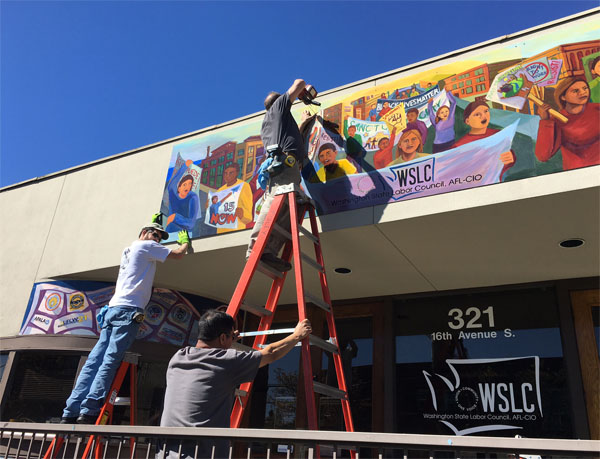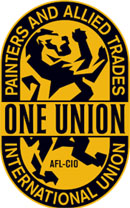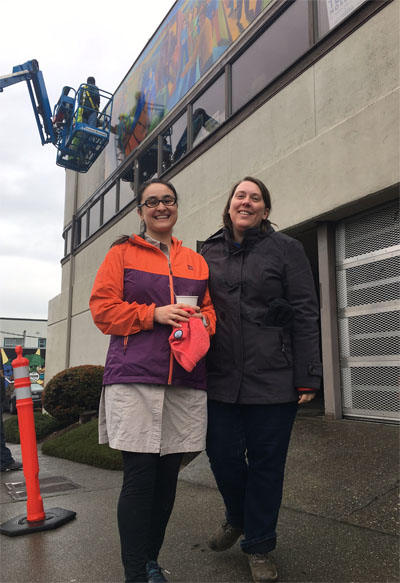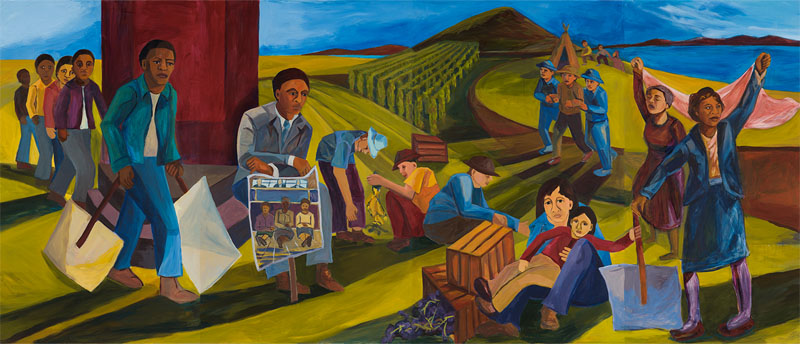OPINION
A rewarding journey for artists of the Jackson St. Workers Mural
By KATHERINE CHILCOTE
SEATTLE (April 28, 2017) — The Jackson Street Workers Mural was a three-year experience of close collaboration between myself and fellow artist Devon Midori Hale. Installed last week and set to be unveiled at a block party on Sunday, April 30, this 350-foot mural is a depiction of labor history. In particular, we highlighted key events that occurred in the International and Central districts, which meet at 16th & Jackson where the mural is located on the Washington State Labor Council building.
Beverly Naidus of the University of Washington-Tacoma interviewed more than 65 artists to find the right team for this project. I have been painting murals as Director of Building Bridges Arts Collaborative for 10 years, but painting labor history was a new undertaking. As lead artist, my aim was to find the most cohesive way to collaborate with another artist and Devon proved to be a great fit and a critical contributor to this project. Together, we were able to establish a unique and productive approach to our collaboration.
For each of the mural subjects explored, many neighbors, union representatives, and community members were asked to discuss what portions of labor history were most important to them. Starting in 2014, more than 800 attended public charrettes to help identify which subjects to feature.
For me, one of the most meaningful sections features the history of Seattle’s fight for access to affordable housing. This section features key events such as sit-in at real estate agencies conducted by civil rights group CORE and protests led by LELO. This section depicts the members of CORE on the steps of an ambiguous home, only shown through a free-standing red closed door. The light composition in this section is strong and direct to show the dramatic yet solemn service these organizations did on housing reform issues. Painted inside the protest sign is a depiction of the historic sit-in at a Seattle City Council meeting to fight for housing reform. The mural shows housing reform in the ’60s and ’70s, but affordable housing is still a pressing issue for the Central and International District neighbors today.
The expression of the sit-ins was painted adjacent to the hops pickers and grape workers. In 1965, Filipino American grape workers walked out on strike against Delano, Calif., grape growers. The empty fields and fallen crates of grapes lie in front of the Washington state organizers of wildcat strikes in Yakima Valley hops farms.
The mural continues from there to feature the Coalition of Labor Union Women, the Fort Lawton Takeover featuring Bernie Whitebear, and the Kingdome International District protests. To paint key events that are each deserving of their own mural, we moved sections around and composed the picture in a way that depicts the common underlying message of fair reform for all.
As a native to the Midwest Rust Belt, where Steelworkers were the main union force, Seattle’s labor voice has been quite diverse. We heard from a remarkably vast array of unions about their values, neighborhood identities, vision for retelling labor history, and finding ordinary heroes.
We have been incredibly grateful for this project, the rich history we have learned, the growth we have experienced as artists, and for the opportunity to have Jackson Street as our canvas.
We have also been grateful to have a union of our own!
Over the past three years of design and painting, Devon and I have been members of the International Union of Painters and Allied Trades, and Building Bridges Arts Collaborative has become a signatory business of IUPAT. It may sound simple, but adapting to IUPAT standards and business practices was a major change for two artists and an emerging non-profit organization.

The mural was installed by Foley Signs Co. and fellow IUPAT Local 1094 members (from left) Jay Martin, Fred Ajeto, and on the ladder, Pat McCambridge.
Wage rates for working artists are usually at minimum wage or lower, and are contingent on the quality and scale of the work completed, not the time spent making the work. To consider our work on the hourly pay scale of industrial painters changed our approach to the work, to each other as individuals, as well as to the use of our time and energy when creating.
 We discovered that unionization can help provide fair economic treatment to the creative class. Not only did we measure our work time hourly rather than by stipends, we incorporated into the cost of the overall project some benefits that the artistic community almost never receives, such as health care insurance, Social Security, and a pension. It has been an interesting transition from a market that does not value or measure our time, talent and treasures in any comparable way to neighboring industrial painters.
We discovered that unionization can help provide fair economic treatment to the creative class. Not only did we measure our work time hourly rather than by stipends, we incorporated into the cost of the overall project some benefits that the artistic community almost never receives, such as health care insurance, Social Security, and a pension. It has been an interesting transition from a market that does not value or measure our time, talent and treasures in any comparable way to neighboring industrial painters.
This project’s financial model provided a far more equitable system for creative production between two artists, one that should be spread across the non-profit and for-profit sectors of public art. This same model was explored during the New Deal era Works Progress Administration (WPA), but visual artists never sustained a unionization beyond that era. Instead, many of us let go of the idea of earning a living wage as working artists, and often times, are essentially breaking even on our expenses — or trying to — while “profiting” only from our mutual investment in the creation of public art.
So we have been proud to uphold the labor standards depicted in a socially driven narrative painting like the Jackson Street Workers Mural. Building Bridges Arts Collaborative will continue as members of IUPAT and is currently searching for our next big wall!
Katherine Chilcote is an artist, Founding Director of Building Bridges Arts Collaborative, and a member of IUPAT Local 1094. Visit the Building Bridges website for more information.







